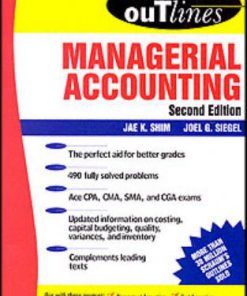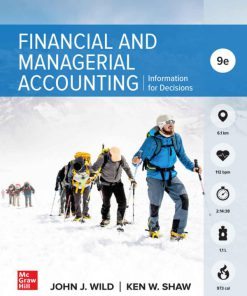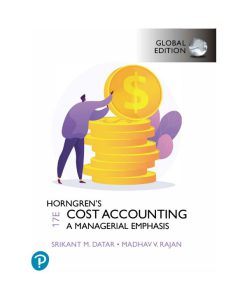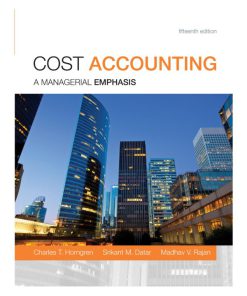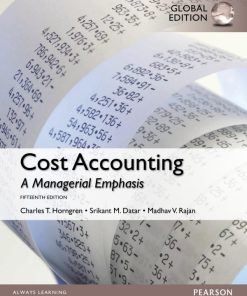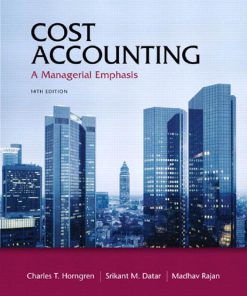Horngren Financial and Managerial Accounting The Managerial Chapters Global Edition 7th Edition by Ella Mae Matsumura, Tracie Miller Nobles, Brenda Mattison ISBN 9781292412313
$50.00 Original price was: $50.00.$25.00Current price is: $25.00.
Authors:Miller-Nobles, Tracie , Series:Management [763] , Author sort:Miller-Nobles, Tracie , Languages:Languages:eng , Published:Published:Jul 2021 , Publisher:Pearson
Horngren Financial and Managerial Accounting The Managerial Chapters Global Edition 7th Edition by Ella Mae Matsumura, Tracie Miller Nobles, Brenda Mattison – Ebook PDF Instant Download/Delivery. 9781292412313
Full download Horngren Financial and Managerial Accounting The Managerial Chapters Global Edition 7th Edition after payment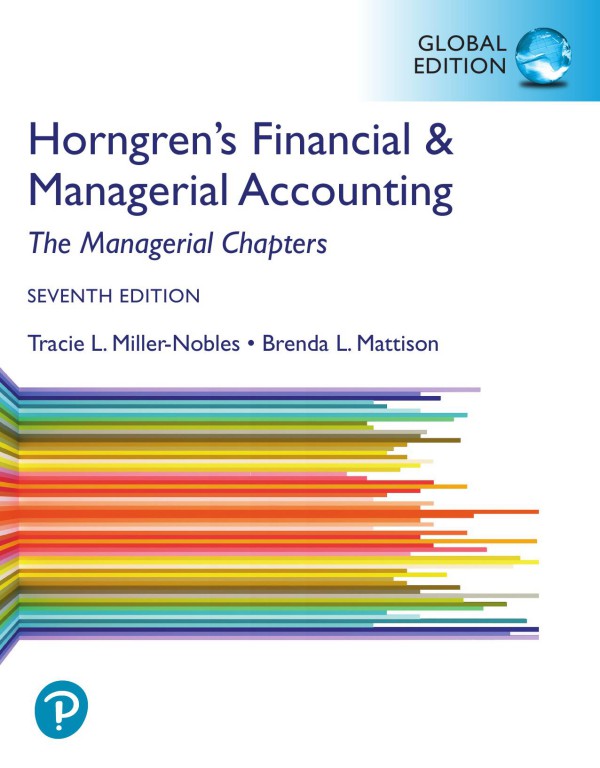
Product details:
ISBN 10:
ISBN 13: 9781292412313
Author: Ella Mae Matsumura, Tracie Miller Nobles, Brenda Mattison
Thelatest, most relevant content helps students see the connection betweenaccounting concepts and real businesses Data and research, including any years and numbers as they relate to real companies (such as Kohl’s and Target), ensures students have relevant examples to help them engage with the course. Discussions of important concepts and calculations help students to better understand the material. They include: Chapter 1 “Accounting and the Business Environment” discusses accountants’ need for technology skills and knowledge. It also clarifies the discussion on equity to help students better understand the changes in equity based on customer feedback. Chapter 2 “Recording Business Transactions” covers data analytics and the chart of accounts. Chapter 5 “Merchandising Operations” clarifies discussion of how a periodic inventory system records estimated sales returns. The order of purchase and sales sections has also been realigned to better explain how a company records these transactions. Chapter 6 “Merchandise Inventory” includes added explanation for how to calculate inventory cost flow for FIFO, LIFO, and weighted average under the perpetual method. Chapter 11 “Current Liabilities and Payroll” contains updated payroll tax information for 2019. Employability coverage throughout the text discusses additional designations accounting majors can earn, including Certified Global Management Accountant (CGMA) and Certified Financial Planner (CFP), and highlights the importance of these credentials in today’s job market. Student-centricfeatures help facilitate learning Data Analytics in Accounting features highlight real companies that are now using data analytics to track inventory, monitor cash flow, forecast sales, and maximize profits. Also discussed are advances in technology, including robotic process automation and artificial intelligence, and how they relate to the work management accountants perform. Key Terms focus on the concepts central to students’ learning, including Lean Management System, Relevant and Irrelevant Revenue, and more. Opportunitiesfor practice help students strengthen their critical-thinking and analysisskills Check Your Understanding boxes let students gauge their comprehension of the material and have been updated to include new accounts introduced under the Revenue Recognition Standard. Tying It All Together boxes tie together key concepts from the chapter using the company highlighted in the chapter opener. Updates to the 7th edition include Chipotle (and the unauthorized malware activity that occurred in April 2017) (chapter 7) and Amazon (chapter 8). End-of-chapter problems and exercises help students build skills to analyze and interpret information and apply reasoning and logic to new or unfamiliar ideas and situations. Updates include: a list of accounts based on customer feedback, and an exercise that specifically incorporates critical-thinking skills (chapter 2). a calculation of interest expense (chapter 3). options for professors who do not want to cover Sales Returns and Allowances (i.e., Estimated Returns Inventory and Refunds Payable) (chapter 5). an exercise for additional practice on journal entries for the allowance method (chapter 8). Reachevery student with MyLab Data Analytics Projects offer students hands-on practice in mining, analyzing, and reporting on data. Each project contains a list of requirements, a dataset from a real company, a tutorial video, and instructions for using software such as Excel, Power BI, or Tableau. Using these tools, students learn how to extract and examine key information about a company related to its products, operations, and consumer buying habits. With this experience and knowledge, students are able to make smarter business decisions and are better prepared for the workforce. Check out the preface for a complete list of features and what’snew in this edition.
Horngren Financial and Managerial Accounting The Managerial Chapters Global Edition 7th Edition Table of contents:
Chapter 1: Introduction to Managerial Accounting
- The Role of Managerial Accounting
- Users of Managerial Accounting Information
- Managerial vs. Financial Accounting
- Ethical Issues in Managerial Accounting
- Cost-Benefit Analysis and Decision-Making
Chapter 2: Job Order Costing
- Basic Costing Concepts
- Job Order Costing System
- Flow of Costs in a Job Order System
- Assigning Costs to Jobs: Direct Materials, Direct Labor, and Manufacturing Overhead
- Analyzing Job Order Costing
- Variances and Under/Over-Applied Overhead
Chapter 3: Process Costing
- Process Costing Overview
- Differences Between Job Order and Process Costing
- The Flow of Costs in a Process Costing System
- Cost Accumulation and Assignment in Process Costing
- Equivalent Units and Calculating Unit Costs
- Process Costing and Transferring Costs
Chapter 4: Cost-Volume-Profit Analysis
- Basic Cost-Volume-Profit Concepts
- Contribution Margin and Breakeven Analysis
- Profit Planning and Decision Making
- Sensitivity Analysis and CVP Models
- The Impact of Changes in Costs, Volume, and Prices
Chapter 5: Variable Costing and Segment Reporting
- Understanding Variable Costing
- Difference Between Absorption and Variable Costing
- Contribution Margin Income Statement
- Segment Reporting and Performance Evaluation
- Breakeven and Target Profit Analysis
Chapter 6: Master Budgets and Responsibility Accounting
- The Purpose of Budgets in Management
- Components of a Master Budget: Sales, Production, Direct Materials, Direct Labor, Overhead, and Financial Budgets
- Budgeting Process and Variance Analysis
- Responsibility Accounting and Performance Evaluation
- Flexible Budgets
Chapter 7: Flexible Budgets, Direct Costs, and Standard Costs
- Flexible Budgets for Variance Analysis
- Standard Costs and Their Role in Budgeting
- Calculating and Analyzing Variances: Price and Quantity Variances
- The Role of Variance Analysis in Cost Control
- Responsibility for Variances
Chapter 8: Performance Measurement and Balanced Scorecard
- Performance Measurement in Managerial Accounting
- Key Performance Indicators (KPIs) and Financial Performance Metrics
- The Balanced Scorecard Approach: Financial, Customer, Internal Processes, and Learning & Growth Perspectives
- Using the Balanced Scorecard for Strategic Decision Making
- Evaluation and Performance Reporting
Chapter 9: Differential Analysis and Product Costing
- Decision-Making Using Differential Analysis
- Contribution Margin and Relevant Costs
- Make or Buy Decisions
- Special Order Decisions
- Product Costing for Decision Making
- Sunk Costs and Opportunity Costs
Chapter 10: Capital Budgeting
- Capital Budgeting Overview
- Methods of Capital Budgeting: Payback Period, Net Present Value (NPV), Internal Rate of Return (IRR), and Profitability Index
- Risk and Uncertainty in Capital Budgeting
- Evaluating Long-Term Investments
- Capital Rationing and Risk Analysis
Chapter 11: Decentralization and Performance Evaluation
- Decentralized Organizations and Responsibility Centers
- Types of Responsibility Centers: Cost Centers, Profit Centers, and Investment Centers
- Performance Evaluation Metrics: Return on Investment (ROI), Residual Income (RI), and Economic Value Added (EVA)
- Transfer Pricing Methods
- Evaluating Managerial Performance
Chapter 12: Activity-Based Costing and Management
- Activity-Based Costing (ABC) Overview
- How ABC Differs from Traditional Costing Systems
- Identifying and Assigning Activity Costs
- Using ABC for Cost Management and Decision-Making
- Activity-Based Management and Cost Reduction Strategies
Chapter 13: Just-in-Time and Total Quality Management
- Just-in-Time (JIT) Inventory Management System
- The Role of JIT in Reducing Waste and Improving Efficiency
- Total Quality Management (TQM) Overview
- Implementing TQM for Continuous Improvement
- Cost of Quality and Measuring Quality Performance
Chapter 14: Budgeting and Financial Forecasting
- Overview of Financial Forecasting
- Preparing Financial Forecasts and Projections
- The Role of Budgeting in Strategic Planning
- Cash Flow Forecasting and Managing Liquidity
- Sensitivity Analysis in Financial Forecasting
Chapter 15: Strategic Cost Management
- The Role of Cost Management in Strategic Planning
- Value Chain Analysis
- Outsourcing and Offshoring Decisions
- Activity-Based Costing for Strategic Decision-Making
- Cost Leadership vs. Differentiation Strategy
Appendices
People also search for Horngren Financial and Managerial Accounting The Managerial Chapters Global Edition 7th Edition:
horngren’s financial & managerial accounting pdf
horngren’s financial & managerial accounting the financial chapters 8th
horngren’s financial & managerial accounting the managerial chapters 7th edition
horngren’s financial & managerial accounting 6th edition




